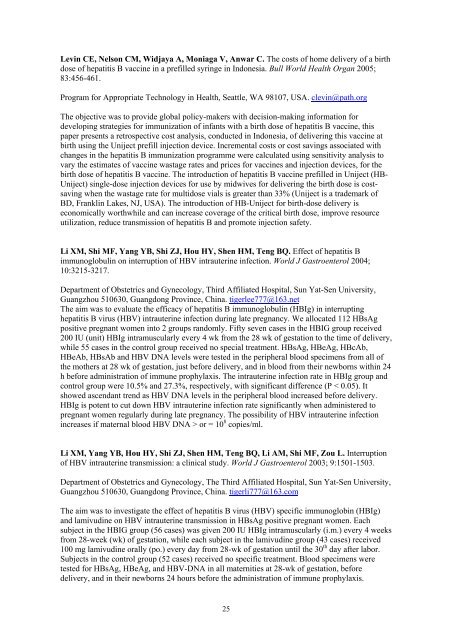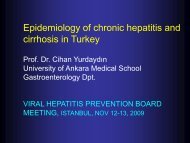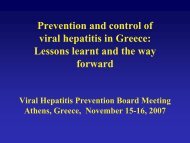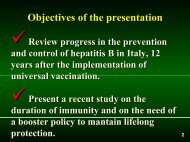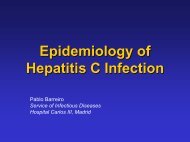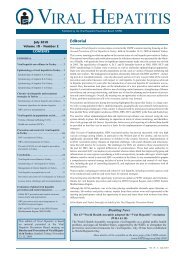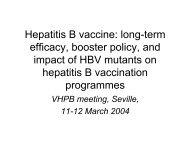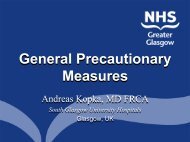majority (28 out <strong>of</strong> 34) <strong>of</strong> these non-responder newborns but never <strong>in</strong> the other newborns whoresponded to the HBsAg vacc<strong>in</strong>e. HBV genome was detected <strong>in</strong> serum, only <strong>in</strong> some cases (n<strong>in</strong>eout <strong>of</strong> 34) <strong>and</strong> never <strong>in</strong> the absence <strong>of</strong> HBV DNA <strong>in</strong> PBMC. For n<strong>in</strong>e out <strong>of</strong> 14 followednewborns, the absence <strong>of</strong> response was transitory s<strong>in</strong>ce anti-HBs Abs appeared after 15 months,without booster, while the HBV genome had disappeared. Unresponsiveness was specific to theHBV envelope prote<strong>in</strong> s<strong>in</strong>ce all late responders <strong>and</strong> 15-months-non-responders to the HBsAgvacc<strong>in</strong>e produced normal levels <strong>of</strong> Abs to the three polio<strong>virus</strong> serotypes, to tetanus toxoid <strong>and</strong> tothe pneumococcus polysaccharides. An <strong>in</strong> utero <strong>in</strong>duced immune tolerance to low doses <strong>of</strong> HBsAgappears as the most plausible hypothesis to expla<strong>in</strong> this unresponsiveness to HBV vacc<strong>in</strong>e.Lee C, Gong Y, Brok J, Boxall EH, Gluud C. Effect <strong>of</strong> <strong>hepatitis</strong> B immunisation <strong>in</strong> newborn<strong>in</strong>fants <strong>of</strong> mothers positive for <strong>hepatitis</strong> B surface antigen: systematic review <strong>and</strong> meta-analysis.BMJ 2006; 332:328-336.Cochrane Hepato-Biliary Group, Copenhagen Trial Unit, Copenhagen University Hospital,Denmark.The objective was to evaluate the effects <strong>of</strong> <strong>hepatitis</strong> B vacc<strong>in</strong>e <strong>and</strong> immunoglobul<strong>in</strong> <strong>in</strong> newborn<strong>in</strong>fants <strong>of</strong> mothers positive for <strong>hepatitis</strong> B surface antigen. Design: Systematic review <strong>and</strong> metaanalysis<strong>of</strong> r<strong>and</strong>omised cl<strong>in</strong>ical trials. Data sources: electronic databases <strong>and</strong> h<strong>and</strong> searches.R<strong>and</strong>omised cl<strong>in</strong>ical trials were assessed for methodological quality. Meta-analysis wasundertaken on three outcomes: the relative risks <strong>of</strong> <strong>hepatitis</strong> B occurrence, antibody levels to<strong>hepatitis</strong> B surface antigen, <strong>and</strong> adverse events. 29 r<strong>and</strong>omised cl<strong>in</strong>ical trials were identified, five<strong>of</strong> which were considered high quality. Only three trials reported <strong>in</strong>clusion <strong>of</strong> mothers negative for<strong>hepatitis</strong> B e antigen. Compared with placebo or no <strong>in</strong>tervention, vacc<strong>in</strong>ation reduced theoccurrence <strong>of</strong> <strong>hepatitis</strong> B (relative risk 0.28, 95% confidence <strong>in</strong>terval 0.20 to 0.40; four trials). Nosignificant difference <strong>in</strong> <strong>hepatitis</strong> B occurrence was found between recomb<strong>in</strong>ant vacc<strong>in</strong>e <strong>and</strong>plasma derived vacc<strong>in</strong>e (1.00, 0.71 to 1.42; four trials) <strong>and</strong> between high dose versus low dosevacc<strong>in</strong>e (plasma derived vacc<strong>in</strong>e 0.97, 0.55 to 1.68, three trials; recomb<strong>in</strong>ant vacc<strong>in</strong>e 0.78, 0.31 to1.94, one trial). Compared with placebo or no <strong>in</strong>tervention, <strong>hepatitis</strong> B immunoglobul<strong>in</strong> or thecomb<strong>in</strong>ation <strong>of</strong> plasma derived vacc<strong>in</strong>e <strong>and</strong> <strong>hepatitis</strong> B immunoglobul<strong>in</strong> reduced <strong>hepatitis</strong> Boccurrence (immunoglobul<strong>in</strong> 0.50, 0.41 to 0.60, one trial; vacc<strong>in</strong>e <strong>and</strong> immunoglobul<strong>in</strong> 0.08, 0.03to 0.17, three trials). Compared with vacc<strong>in</strong>e alone, vacc<strong>in</strong>e plus <strong>hepatitis</strong> B immunoglobul<strong>in</strong>reduced <strong>hepatitis</strong> B occurrence (0.54, 0.41 to 0.73; 10 trials). Hepatitis B vacc<strong>in</strong>e <strong>and</strong> <strong>hepatitis</strong> Bimmunoglobul<strong>in</strong> seem safe, but few trials reported adverse events. Hepatitis B vacc<strong>in</strong>e, <strong>hepatitis</strong> Bimmunoglobul<strong>in</strong>, <strong>and</strong> vacc<strong>in</strong>e plus immunoglobul<strong>in</strong> prevent <strong>hepatitis</strong> B occurrence <strong>in</strong> newborn<strong>in</strong>fants <strong>of</strong> mothers positive for <strong>hepatitis</strong> B surface antigen.Lee SS, Young BW, Wong KH, Lim WL. The implication <strong>of</strong> a reduced-dose <strong>hepatitis</strong> Bvacc<strong>in</strong>ation schedule <strong>in</strong> low risk newborns. Vacc<strong>in</strong>e 2002; 20:3752-3754.Department <strong>of</strong> Health, Hong Kong SAR Government, Hong Kong, Ch<strong>in</strong>a. ss_lee@dh.gov.hkFive hundred <strong>and</strong> seventy-four babies born to HBsAg negative mothers <strong>in</strong> Hong Kong receivedeither a regular (5 µg) or reduced (2.5 µg) three-dose regimen <strong>of</strong> recomb<strong>in</strong>ant <strong>hepatitis</strong> B vacc<strong>in</strong>e.A significantly higher anti-HBs positivity rate (> or = 10 mIU/ml), geometric mean titer (GMT)<strong>and</strong> the ma<strong>in</strong>tenance <strong>of</strong> a high anti-HBs level (> or = 100 mIU/ml) were observed with the regulardoseregimen. The differences persisted, however, only up to 1 year post-vacc<strong>in</strong>ation. Over an 8-year period, only 1% <strong>of</strong> the vacc<strong>in</strong>ees demonstrated anti-HBc seroconversion <strong>and</strong> none hadbecome HBsAg positive. The long-term efficacy <strong>of</strong> the reduced-dose regimen was confirmed,even <strong>in</strong> an HBV endemic population.24
Lev<strong>in</strong> CE, Nelson CM, Widjaya A, Moniaga V, Anwar C. The costs <strong>of</strong> home delivery <strong>of</strong> a birthdose <strong>of</strong> <strong>hepatitis</strong> B vacc<strong>in</strong>e <strong>in</strong> a prefilled syr<strong>in</strong>ge <strong>in</strong> Indonesia. Bull World Health Organ 2005;83:456-461.Program for Appropriate Technology <strong>in</strong> Health, Seattle, WA 98107, USA. clev<strong>in</strong>@path.orgThe objective was to provide global policy-makers with decision-mak<strong>in</strong>g <strong>in</strong>formation fordevelop<strong>in</strong>g strategies for immunization <strong>of</strong> <strong>in</strong>fants with a birth dose <strong>of</strong> <strong>hepatitis</strong> B vacc<strong>in</strong>e, thispaper presents a retrospective cost analysis, conducted <strong>in</strong> Indonesia, <strong>of</strong> deliver<strong>in</strong>g this vacc<strong>in</strong>e atbirth us<strong>in</strong>g the Uniject prefill <strong>in</strong>jection device. Incremental costs or cost sav<strong>in</strong>gs associated withchanges <strong>in</strong> the <strong>hepatitis</strong> B immunization programme were calculated us<strong>in</strong>g sensitivity analysis tovary the estimates <strong>of</strong> vacc<strong>in</strong>e wastage rates <strong>and</strong> prices for vacc<strong>in</strong>es <strong>and</strong> <strong>in</strong>jection devices, for thebirth dose <strong>of</strong> <strong>hepatitis</strong> B vacc<strong>in</strong>e. The <strong>in</strong>troduction <strong>of</strong> <strong>hepatitis</strong> B vacc<strong>in</strong>e prefilled <strong>in</strong> Uniject (HB-Uniject) s<strong>in</strong>gle-dose <strong>in</strong>jection devices for use by midwives for deliver<strong>in</strong>g the birth dose is costsav<strong>in</strong>gwhen the wastage rate for multidose vials is greater than 33% (Uniject is a trademark <strong>of</strong>BD, Frankl<strong>in</strong> Lakes, NJ, USA). The <strong>in</strong>troduction <strong>of</strong> HB-Uniject for birth-dose delivery iseconomically worthwhile <strong>and</strong> can <strong>in</strong>crease coverage <strong>of</strong> the critical birth dose, improve resourceutilization, reduce <strong>transmission</strong> <strong>of</strong> <strong>hepatitis</strong> B <strong>and</strong> promote <strong>in</strong>jection safety.Li XM, Shi MF, Yang YB, Shi ZJ, Hou HY, Shen HM, Teng BQ. Effect <strong>of</strong> <strong>hepatitis</strong> Bimmunoglobul<strong>in</strong> on <strong>in</strong>terruption <strong>of</strong> HBV <strong>in</strong>trauter<strong>in</strong>e <strong>in</strong>fection. World J Gastroenterol 2004;10:3215-3217.Department <strong>of</strong> Obstetrics <strong>and</strong> Gynecology, Third Affiliated Hospital, Sun Yat-Sen University,Guangzhou 510630, Guangdong Prov<strong>in</strong>ce, Ch<strong>in</strong>a. tigerlee777@163.netThe aim was to evaluate the efficacy <strong>of</strong> <strong>hepatitis</strong> B immunoglobul<strong>in</strong> (HBIg) <strong>in</strong> <strong>in</strong>terrupt<strong>in</strong>g<strong>hepatitis</strong> B <strong>virus</strong> (HBV) <strong>in</strong>trauter<strong>in</strong>e <strong>in</strong>fection dur<strong>in</strong>g late pregnancy. We allocated 112 HBsAgpositive pregnant women <strong>in</strong>to 2 groups r<strong>and</strong>omly. Fifty seven cases <strong>in</strong> the HBIG group received200 IU (unit) HBIg <strong>in</strong>tramuscularly every 4 wk from the 28 wk <strong>of</strong> gestation to the time <strong>of</strong> delivery,while 55 cases <strong>in</strong> the <strong>control</strong> group received no special treatment. HBsAg, HBeAg, HBcAb,HBeAb, HBsAb <strong>and</strong> HBV DNA levels were tested <strong>in</strong> the peripheral blood specimens from all <strong>of</strong>the mothers at 28 wk <strong>of</strong> gestation, just before delivery, <strong>and</strong> <strong>in</strong> blood from their newborns with<strong>in</strong> 24h before adm<strong>in</strong>istration <strong>of</strong> immune prophylaxis. The <strong>in</strong>trauter<strong>in</strong>e <strong>in</strong>fection rate <strong>in</strong> HBIg group <strong>and</strong><strong>control</strong> group were 10.5% <strong>and</strong> 27.3%, respectively, with significant difference (P < 0.05). Itshowed ascendant trend as HBV DNA levels <strong>in</strong> the peripheral blood <strong>in</strong>creased before delivery.HBIg is potent to cut down HBV <strong>in</strong>trauter<strong>in</strong>e <strong>in</strong>fection rate significantly when adm<strong>in</strong>istered topregnant women regularly dur<strong>in</strong>g late pregnancy. The possibility <strong>of</strong> HBV <strong>in</strong>trauter<strong>in</strong>e <strong>in</strong>fection<strong>in</strong>creases if maternal blood HBV DNA > or = 10 8 copies/ml.Li XM, Yang YB, Hou HY, Shi ZJ, Shen HM, Teng BQ, Li AM, Shi MF, Zou L. Interruption<strong>of</strong> HBV <strong>in</strong>trauter<strong>in</strong>e <strong>transmission</strong>: a cl<strong>in</strong>ical study. World J Gastroenterol 2003; 9:1501-1503.Department <strong>of</strong> Obstetrics <strong>and</strong> Gynecology, The Third Affiliated Hospital, Sun Yat-Sen University,Guangzhou 510630, Guangdong Prov<strong>in</strong>ce, Ch<strong>in</strong>a. tigerli777@163.comThe aim was to <strong>in</strong>vestigate the effect <strong>of</strong> <strong>hepatitis</strong> B <strong>virus</strong> (HBV) specific immunoglob<strong>in</strong> (HBIg)<strong>and</strong> lamivud<strong>in</strong>e on HBV <strong>in</strong>trauter<strong>in</strong>e <strong>transmission</strong> <strong>in</strong> HBsAg positive pregnant women. Eachsubject <strong>in</strong> the HBIG group (56 cases) was given 200 IU HBIg <strong>in</strong>tramuscularly (i.m.) every 4 weeksfrom 28-week (wk) <strong>of</strong> gestation, while each subject <strong>in</strong> the lamivud<strong>in</strong>e group (43 cases) received100 mg lamivud<strong>in</strong>e orally (po.) every day from 28-wk <strong>of</strong> gestation until the 30 th day after labor.Subjects <strong>in</strong> the <strong>control</strong> group (52 cases) received no specific treatment. Blood specimens weretested for HBsAg, HBeAg, <strong>and</strong> HBV-DNA <strong>in</strong> all maternities at 28-wk <strong>of</strong> gestation, beforedelivery, <strong>and</strong> <strong>in</strong> their newborns 24 hours before the adm<strong>in</strong>istration <strong>of</strong> immune prophylaxis.25
- Page 1 and 2: Pre-meeting documentPrevention and
- Page 3 and 4: Part I Prevention and control of pe
- Page 5 and 6: prevalence was significantly higher
- Page 7 and 8: clusters (obstetrics wards/hospital
- Page 9 and 10: Boxall E. Screening of pregnant wom
- Page 11 and 12: Chang MH, Hsu HY, Huang LM, Lee PI,
- Page 13 and 14: of infection in infants and childre
- Page 15 and 16: Eriksen EM, Perlman JA, Miller A, M
- Page 17 and 18: liver enzyme abnormalities than wer
- Page 19 and 20: health care, is feasible and achiev
- Page 21 and 22: HBsAg and anti-HBs in 4.5%. In the
- Page 23: immunoprophylaxis. Reflecting effec
- Page 27 and 28: Delaying vaccination of premature i
- Page 29 and 30: diagnosis. In the past, the inciden
- Page 31 and 32: shows that the prevalence of HBV in
- Page 33 and 34: Niu MT, Targonski PV, Stoll BJ, Alb
- Page 35 and 36: Ranger-Rogez S, Alain S, Denis F. H
- Page 37 and 38: vaccinees) and low reactogenicity o
- Page 39 and 40: single ELISA test is about Rs40. At
- Page 41 and 42: newborns with surface antigenemia,
- Page 43 and 44: Wang Z, Zhang J, Yang H, Li X, Wen
- Page 45 and 46: of hepatitis B vaccine. This study
- Page 47 and 48: transmission has been estimated at
- Page 49 and 50: at birth and 2 weeks after birth, f
- Page 51 and 52: Chubinishvili OV, Mikhailov MI, Sak
- Page 53 and 54: Jensen L, Heilmann C, Smith E, Want
- Page 55 and 56: Onishchenko GG. Incidence of infect
- Page 57: Zanetti A, Tanzi E, Semprini AE. He


